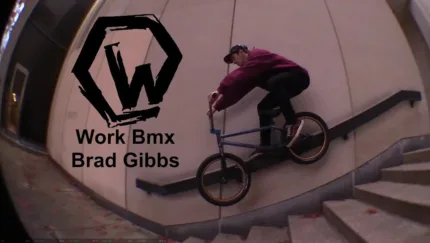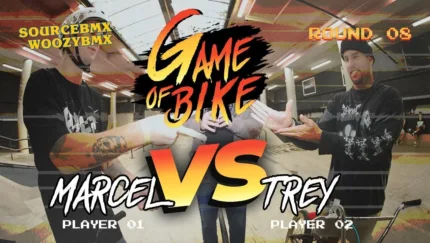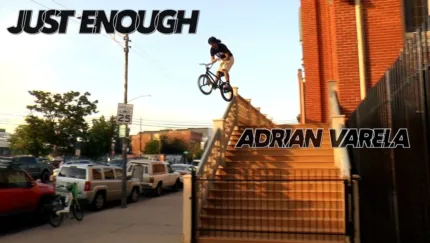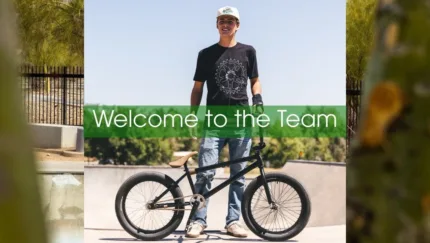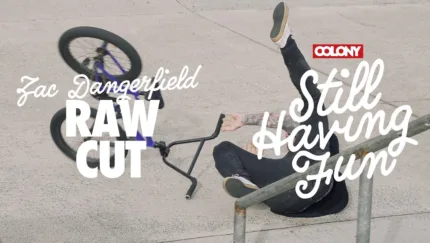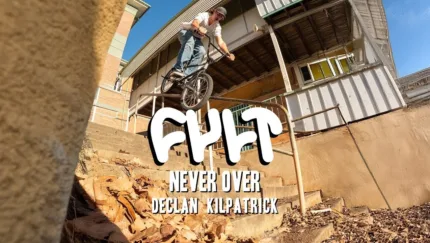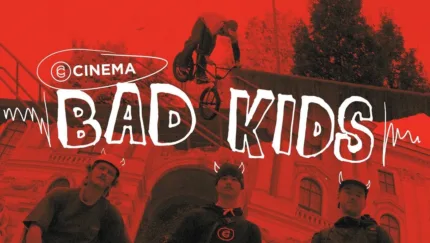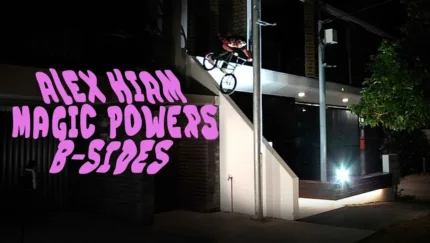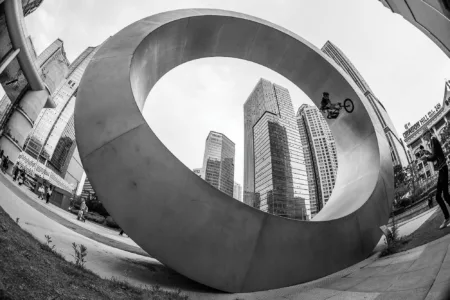
Pascal Lafontaine - OUR DIG 2019 RIDER OF THE YEAR
"I Thought I'd Never Ride Again"
Interview by Fred Murray | Photos by Pierre Gauthier
A Exclusive Extract from DIG ISSUE 99.99
DIG Rider Of The Year is always a hell of a task to decide on but this year was easier than most. There's a lot of incredible humans out there but one rider stood out more than others due to his relentless motivation in the face of major adversity - Pascal Lafontaine. Following on from being diagnosed with cancer back in 2015 and then a leg amputation soon after, Pascal stunned the bike community this year with the release of his unbelievable comeback video. We aren't talking average riding either - this was technical riding beyond 99% of most people's ability and burly moves that even Sean Burns would be proud of. A true hero and inspiration.


My phone buzzed on the table. Upon receiving that first message from Pascal I didn’t recognise his name, although it turns out I had watched his last video part a good four years ago and was more than impressed. His email was titled Pascal Lafontaine DIG Exclusive with no mention of what I was about to watch apart from the short message: “Hi, I’m Pascal Lafontaine and this is my latest video project I made.” I hit play and couldn’t believe my eyes—a young man with a prosthetic leg sending it harder than hell. How had this guy gone under my radar?! After a couple of emails back and forth, I had to know more. Fast forward to a month after his video release on DIG and I was talking to the man himself via video message:
“I’ve not been up to much since the video came out. I got some radiotherapy treatments so I need to rest a little bit. Right now I'm in my bed watching family guy.”

“Some of the chemotherapy was so bad that I was sleeping for about three weeks of the month. So yeah, I’ve tried my best dealing with all of it.”- Pascal Lafontaine
I asked him about his diagnosis.
“I was 22-years-old – I am 28 now. They told me I had sarcoma bone cancer. It is a type of bone cancer, but localized and normally is in the knee. But for me it was my foot. They had to take me in the same month that they diagnosed me and after that they told me I would have to do not only radiotherapy, but chemotherapy. The chemotherapy wasn't working well and the cancer actually came back in my lungs because they diagnosed the wrong cancer. Now they think it was my soft tissue. It wasn't in my bones. I'm in this 1% of people where you cannot diagnose the type of sarcoma. So they gave me the wrong chemotherapy. It didn't work at all. After that I got other types of chemotherapy and like I said, I'm still trying different treatment because they don't really know exactly which cells they need to kill. But the radiotherapy is working very well on me every time, however the cancer is coming back –the radiotherapy is just slowing it down. We need to find something that will really kill it. We are working on it. I filmed for the video and did chemotherapy at the same time. That's why it took two years for the video to come out. I was only really able to film for a couple months. So yeah, I've tried my best dealing with all of it. Some of the chemotherapy was so bad that I was sleeping for about three weeks of the month. Some of it is a pretty bad kind of chemotherapy. We had to change the treatments often because sometimes they would stop working. So yeah, sometimes I lose my hair, sometimes I don’t.”


Pascal runs his fingers through his hair showing me how his current hair growth is going. At this point, I couldn’t stop thinking how fucking unfair it all seemed. Pascal was only 22 when he was diagnosed. Not only does he still have to face the illness, he also had to lose his leg. I’ve met amputees before and always wondered how someone comes to terms with such a life changing trauma.
“I thought I’d never ride again. I thought that I could maybe stay in the BMX game as a filmmaker or something. Just do some videos for my friends—you know—but I really thought that I wasn’t going to be able to ride anymore. I tried to ride in 2015, again in 2016, and once more in 2017; but I was just not able to do it because my prosthetic leg was hurting. What really got me into riding again was when I realized that the alignment of my prosthetic was all wrong. I was playing golf at the time and had been trying a different alignment with my leg. It was in 2018 when I went to the skatepark to see my friend. I very nearly didn’t bring my bike as I was just planning on watching him ride. Anyway, that was the time I realized that I could make it work. It wasn’t a problem with the leg, it was just the way I was using it. It was the angle I needed to change. Because it’s my back foot, the prosthetic needed to point up a little more than 90 degrees. Before that, my leg would just slip off the pedal every time.”
Incredibly, up until this point of realisation, Pascal had been trying to ride with a magnet attached to his shoe and pedal.
“The magnet was okay, but the bad thing was that when I was grinding the magnet was sticking onto the rail. So it was good for some tricks, but honestly it was not the best idea for riding BMX. It’s something that I think would be great for mountain bikes though. Now, I like plastic pedals with metal pins. They are pretty expensive though! It’s all about the Vans with waffle cup and metal pins!"


If you didn’t know Pascal’s riding style, you might show up at a location with him wondering what the actual spot was—only to find out a few moments later that he was going to send it off the roof.
“I feel like my foot is still there sometimes. Like, sometimes I feel like I’m moving it.”
- Pascal Lafontaine
It was at this point that I quizzed him on what he did in those years when he couldn’t ride his bike.
“It was hard at the beginning trying to find a new passion. Up until then, BMX was my whole life, you know? I was riding every day – just school and then riding for probably six hours afterwards. It was a big deal for me at first. I had to find something else. I tried playing golf. I ended up playing every day and even did some tournaments. It just wasn’t the same as BMX. I got tired of golf after those three years. I didn’t specifically try and get back into BMX – it just kind of happened. I split my time between the two for a while, but decided to just go in full-on with the BMX. But yeah, the process was hard mentally. Once I could ride again, I’d only had two sessions and then we started filming for my video. I wasn't planning on going big or anything. For me it was just about motivating other people. I just knew that if people were seeing that I could ride again, whatever they were facing, they could do it. Even if they weren’t riding BMX, I just wanted to motivate other people no matter what level of injury it is. After filming for a while I found that I wasn’t fully satisfied and started to push myself some more. I think I was also comparing my riding to how it was before my amputation. I filmed three clips in 2018, but decided to wait a while and redo them when I had more practice. It’s strange—if I had always had a prosthetic leg and then started to ride BMX I don’t think I’d be able to learn things like tailwhips, but I can remember what it feels like to do one with two feet, so I can almost make it feel the same. But yeah, I put all of myself into the video.”

A lot of reconnaissance was required for this spot as the owner of this motel was on site 24/7 waiting to see if we would come back.
Regardless of the small drop before the stairs on the run-up, Pascal landed this over-tooth three or four times.
'Phantom pain' is a feeling of pain in an absent limb or a portion of a limb. The pain sensation varies from individual to individual and unfortunately Pascal experienced it badly.
“The first few weeks after my amputation I kept feeling my leg that wasn’t there anymore and got phantom pains. It’s really painful. It actually feels like you’re getting cut. Obviously I wasn’t conscious when they cut my leg off, but I kept feeling the pain like it was happening all over again. They said it was probably so bad because I was very young. More than half of the people who get a leg amputated are diabetic, so usually older than I was. For some reason, when you are older you have less feeling in your nerves. But yeah, it can still happen. I feel like my foot is still there sometimes. Like, sometimes I feel like I’m moving it.”
With all that in mind, I wanted to know how long it took from the time of his amputation to actually being able to walk with the prosthetic leg.
“It's not hard to walk again once you can actually fit the prosthetic leg. After amputation the leg is really swollen and sore and needs to heal. For me I wasn’t able to walk for two months. After that, they put you on a fake leg. You cannot really move your knee, you know – it’s like putting it in a big bag. You have to walk with crutches. A few months later you get a prosthetic leg that’s made just for you. It wasn’t that hard honestly. It really all comes down to if you get given a good foot or not. If you can’t get an expensive one with a good rebound on the ankle, then it’s a lot more difficult. But I’m lucky. I’m in Canada. It’s all covered! It’s really expensive. I broke my fake foot a lot filming for the video – probably like 20 times. It got to a point when I broke my foot off again and the company who makes it got so mad at me. They said they couldn’t do it—I had to pay for it that time. It was the third foot in one month! I broke it off those three times at the same spot trying a 360 gap. $2000 it cost for the new foot. I could have changed the company and got it for free, but I really liked the foot and wanted to carry on filming. I can’t imagine how you could do it if you had to pay for it every time. I received a lot of messages from people all around the world after I dropped that video and a lot of them have to pay for everything themselves. There are probably a lot of riders who have had amputations who can’t ride again because of that. I’ve seen photos of some of the people and they have a wooden foot. It’s really sad to see. It’s just so expensive.”

"For me it was just about motivating other people. I just knew that if people were seeing that I could ride again, whatever they were facing, they could do it. Even if they weren’t riding BMX, I just wanted to motivate other people no matter what level of injury it is."
- Pascal Lafontaine

The run-up for this monster bank was ridiculously small so Dominic helped Pascal stand up so he could do a freecoaster bitch-crank to bar. I still don’t know how he managed to send it first try.
It was almost time to wrap up our conversation but I was curious to know one more thing: had many riders with amputated limbs been in contact with him?
“Um, almost like 20 riders. And more messages from people just doing sports in general. Actually, you know, there were even some people that were just trying to live their life at fifty years old—trying to get up every day with a prosthetic leg. Some of them contacted me because their kids had shown them the video. It really changes your life. I can't do everything that I was doing before—and I don’t just mean on my bike—but actually my entire day. I have so many appointments to go to. And just mentally… it really got the best of me. You’re young and you think you’ll never get sick, but yeah…the cancer in general, not just the prosthetic leg, it’s tough. But I think it made me more interested in other people – I can relate to other people with injuries and sickness. I used to be much more of an introvert. I’m a more open person now. I never thought it would happen to me, but day-to-day, honestly it doesn't change that much. I really wanted to push myself with the video. I don’t expect anything from it, but I just wanted to film it. Before my cancer, I was getting a few sponsors and I was thinking about stuff along that route. But I really don’t have that kind of mind anymore. I mean—I know my riding is nothing like Tyler Fernengel and all those dudes out there. I’m just trying to have fun and learn new tricks on my bike. That’s it.”

Previous
The Good Times Are Killing Us - A TMPRD Berlin Photo Journal
"We were going to Germany baby."
Next
20 Years Of Simple Session - The Risto Kalmre Interview
"I don’t deny it gets a little difficult sometimes"
Related Content











